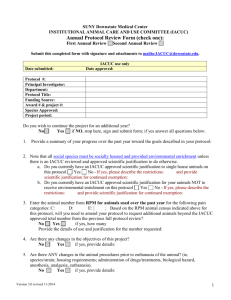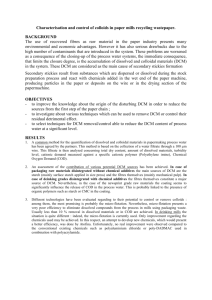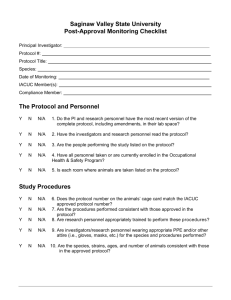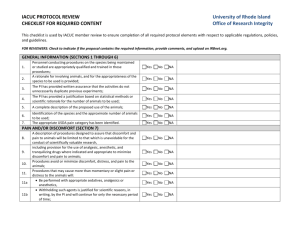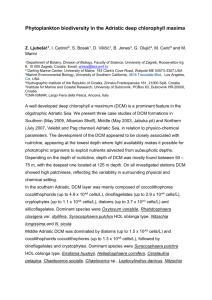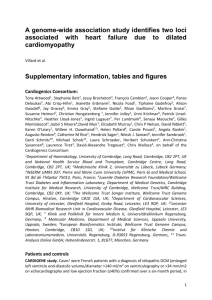animal use protocol application
advertisement
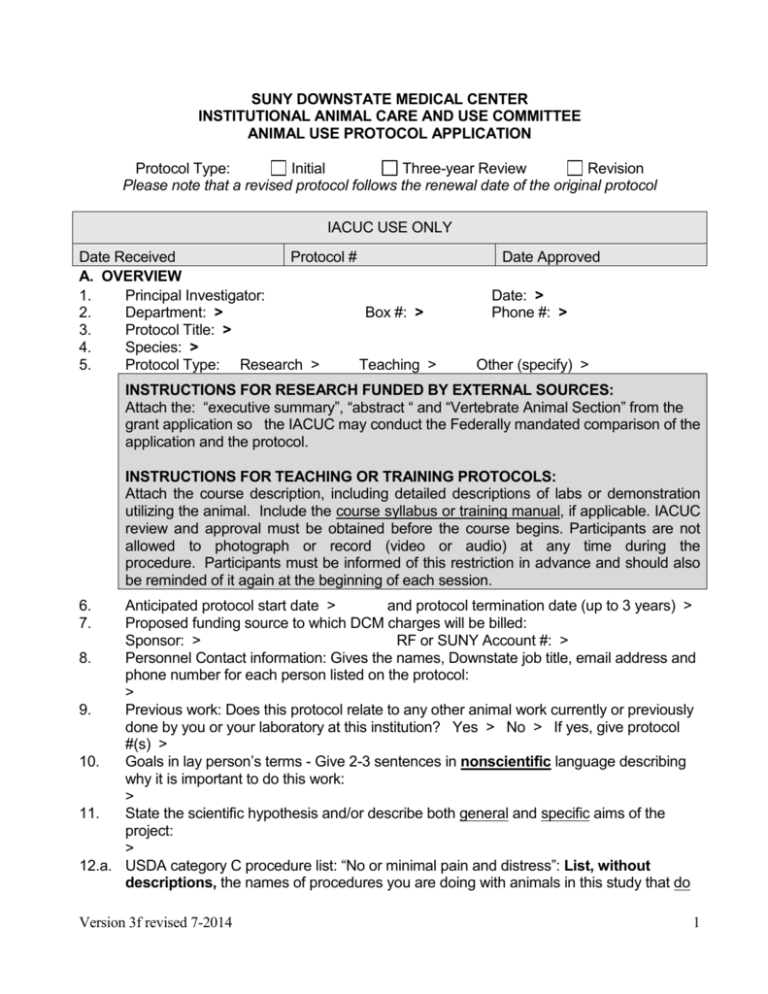
SUNY DOWNSTATE MEDICAL CENTER INSTITUTIONAL ANIMAL CARE AND USE COMMITTEE ANIMAL USE PROTOCOL APPLICATION Protocol Type: Initial Three-year Review Revision Please note that a revised protocol follows the renewal date of the original protocol IACUC USE ONLY Date Received Protocol # A. OVERVIEW 1. Principal Investigator: 2. Department: > Box #: > 3. Protocol Title: > 4. Species: > 5. Protocol Type: Research > Teaching > Date Approved Date: > Phone #: > Other (specify) > INSTRUCTIONS FOR RESEARCH FUNDED BY EXTERNAL SOURCES: Attach the: “executive summary”, “abstract “ and “Vertebrate Animal Section” from the grant application so the IACUC may conduct the Federally mandated comparison of the application and the protocol. INSTRUCTIONS FOR TEACHING OR TRAINING PROTOCOLS: Attach the course description, including detailed descriptions of labs or demonstration utilizing the animal. Include the course syllabus or training manual, if applicable. IACUC review and approval must be obtained before the course begins. Participants are not allowed to photograph or record (video or audio) at any time during the procedure. Participants must be informed of this restriction in advance and should also be reminded of it again at the beginning of each session. 6. 7. Anticipated protocol start date > and protocol termination date (up to 3 years) > Proposed funding source to which DCM charges will be billed: Sponsor: > RF or SUNY Account #: > 8. Personnel Contact information: Gives the names, Downstate job title, email address and phone number for each person listed on the protocol: > 9. Previous work: Does this protocol relate to any other animal work currently or previously done by you or your laboratory at this institution? Yes > No > If yes, give protocol #(s) > 10. Goals in lay person’s terms - Give 2-3 sentences in nonscientific language describing why it is important to do this work: > 11. State the scientific hypothesis and/or describe both general and specific aims of the project: > 12.a. USDA category C procedure list: “No or minimal pain and distress”: List, without descriptions, the names of procedures you are doing with animals in this study that do Version 3f revised 7-2014 1 not require sedation, or anesthesia or analgesia: > 12.b. USDA category D procedure list: “More than momentary pain and distress which is relieved by the use of sedation, and/or anesthesia and/or analgesia”. List, without descriptions, the names of procedures in this category: > 12.c. USDA category E procedure list: “More than momentary pain and distress which is unrelieved.” List, without descriptions, the names of procedures you are doing with animals in this study that require sedation, and/or anesthesia and/or analgesia: > 13. Harm vs. Benefit Analysis – answer this section in 3 parts: 1. How could humans or animals benefit from your experiments? > 2. What are the potential adverse effects of this study on the animals? > 3. How do you, the Principal Investigator, weigh the potential adverse effects of this study against the potential benefits that may result from your research? > B. ANIMAL DESCRIPTION 1. Provide justification for the use of animals: > 2. Provide justification for the use of this species: > 3. List all Strain(s) or Breed(s); note that an addition of new rodent genotypes require a protocol amendment in advance : > 4. Indicate sex, age/weight, and other specifications:> 5. Indicate the preferred source:> 6. Are the animals or will they be genetically modified (transgenic, knockout, etc)? Yes> No> If yes, how does the genetic alteration compromise the welfare of the animals? C. ANIMAL NUMBERS 1 Give the total number of animals for the entire project or three year period: > 2 For the total number of animals requested, indicate the number of animals at the following levels of stress/discomfort (see protocol form instruction website for guidance): C > D > E > 3. Give the power analysis “power” and “alpha” values used for the calculation(s) of sample size: (If you would like to use a free online statistical tools, follow this link: statpages.org): > If you did not use a power analysis, explain how you determined that the number of animals for the entire study was correct: 4. To assist with animal housing planning, how many animals do you anticipate using over Version 3f revised 7-2014 2 the next year? 5. Give the maximum number of animals to be housed at any given time: D. 1. 2. 3. 4. 5. 6. Provide a flow chart describing your experimental design and study groups- be sure to include the number of animals per group, number of groups, all manipulations, experimental procedures and surgeries and timelines. > ANIMAL CARE Indicate the anticipated Basic Science Building housing location room number: > a Describe any requirements for other than routine animal care: > b Will restrictions be placed on any of the following in the conduct of this study: a. the use of social housing- provide justification if any animals will be housed singly (if species is not considered “social”, then so note) b. environmental enrichment or c. the 8th edition Guide compliant cage size Yes No - If yes, please describe the restrictions and provide scientific justification: Describe any additional safety requirements and/or procedures, other than the routine personnel protective equipment (PPE) used by the animal care staff caring for these animals: > Is breeding of these animals at DCM required? Yes > No > If yes, complete the following: a Justification for maintaining breeding colony rather than purchasing animals from a vendor; Note that cost cannot be a factor: > b Select the breeding or mating system: ___Paired (one male/one female) – this is the preferred method to ovoid overcrowding. ___Trio (one male/two females) – if this is selected, explain why Trio breeding is necessary for each strain and/or genotype. > c Is pregnancy to be timed: Yes > No > If yes, how is this to be assured: > d Who will set up breeders, conduct observations, wean offspring and maintain breeding records? > If you are breeding genetically modified mice, and you need to create or maintain a genetic line for this study, give the size of the colony needed to provide the required number of experimental animals:> ___________ To use and append the mouse breeding calculator, go to “Mouse Breeding - Calculate Number of Animals Needed” at http://research.downstate.edu/forms/forms.htm#acucforms a Number of breeders needed for project: Male > Female > b Number of litters needed for the proposed project: > c Number of pre weaned young/pups needed for the proposed project: > Version 3f revised 7-2014 3 6. a b c d Will the animals be genotyped? Yes> No> > If Yes, what age will the animals be when they are genotyped?> What tissue will you be removing from the animals for genotyping?> What method will be used to identify the animals?> Method(s) for disposing of excess animals or animals of the wrong genotype: > E. EXPERIMENTAL PROCEDURES 1. Has a DCM veterinarian been consulted in the development of this protocol? Yes > No > 2. Give the room number(s) in which experimental procedures, surgery, and/or postoperative recovery, if indicated, are to be performed on live animals in this protocol: > 3. Who will perform experimental manipulations of live animals? Procedures Years of Where and individual will be If person is not experience when Name responsible to trained, how will with trained in perform in this training be obtained? species procedures study 4. 5. 6. Briefly describe EVERYTHING DONE TO THE LIVE ANIMAL: All manipulations, experimental procedures, surgeries and timelines should reconcile with the flow chart in Section C.6. > Will animals be subjected to food/water deprivation or prolonged and/or unusual restraint? Yes > No > If yes, describe: > Will any procedure cause more than momentary or slight pain or distress to the animals (USDA Category D or E)? Yes > No > If yes, what alternative procedures were investigated? a. Give at least two search methods/sources: b. the date the search was conducted: c. keywords and dates searched: d. If less painful/distressful procedures were found, justify why you are not using them in this study: Version 3f revised 7-2014 4 7. Is this a USDA category E study in which appropriate anesthetics, analgesics, or tranquilizing drugs are withheld because their use would have adversely affected the teaching, testing, or experiments? No> Yes> If yes, provide scientific justification as to why appropriate intervention such as pain relief is withheld. > 8. For all chemical agents administered to the animals (i.e., experimental, therapeutic, sedatives, analgesics, anesthetics, paralytics, euthanasia) indicate: Type a. b. 9. a b c d e 10. Agent Dosage Route Frequency/interval Total number of doses > Indicate the name(s) of the individual(s) administering each/all of the above agents: > If paralytic agents are used in conjunction with surgical manipulations, indicate the means by which absence of pain is monitored and/or determined, and who is responsible: > Is surgery involved? Yes > No > If yes, indicate whether surgery is survival > or non-survival > and answer the following: Describe monitoring and supportive care provided during surgery (who, what and how will this be done?): > Describe indications for analgesic therapy to be administered before, during, and/or following surgery: > Describe post-operative monitoring and supportive care (who, what and how often?): > Who will maintain anesthetic, surgical, and post-op records? > Where will the records be maintained for Federal, State and IACUC regulatory review? > Is/are animal(s) to be used in more than one major surgical procedure from which it is allowed to recover? Yes > No > If yes, justify: > F. EXPERIMENTAL ENDPOINT CRITERIA AND EUTHANASIA 1. At what planned study time point(s) and/or clinical sign(s) will animals be euthanized? Version 3f revised 7-2014 5 2. 3. 4. 5. > What criteria and/or specific clinical signs will be used for euthanasia of animals prior to study endpoints? > By what method will animals be euthanized? (If a chemical agent is used, indicate also in E9): > By whom will animals be euthanized? > A secondary physical method of euthanasia is required FOR All RODENTS after use of CO2 or profound anesthesia, prior to carcass disposal. Inadequate exposure time to C02 may result in animals that appear dead but can awaken from deep anesthesia. Indicate which of the following procedures will be followed to assure death. ___Decapitation ___Cardiac perfusion ___Removal of vital organs (e.g. heart, lungs, brain) ___Opening of the chest cavity to induce pneumothorax ___Cutting the major blood vessels to induce exsanguination (e.g. aorta, vena cava) ___Cervical dislocation may only be used in adult rodents, as it can be difficult to perform in neonates and thus is not appropriate for use in animals prior to weaning. ___Other (specify): G. SPECIAL CONSIDERATIONS 1. NATURAL PATHOGENS – Will materials potentially transmitting infections agents ie murine derived tumor cell lines or other) be administered to the animals? Yes > No > If yes, describe, indicating whether tests (blood, serum, etc.) or other determinations have been conducted to assure the lines/materials are non-infectious regarding natural pathogens: > 2. HAZARDOUS MATERIALS – Does this work involve any of the following: a Radioactive Yes > No > b Infectious/rDNA Yes > No > c Toxic/Carcinogenic Yes > No > If YES to the above, attach the Biosafety Review Committee approval document to this protocol. 3. EXPLOSIVE AGENT(s) – Use of these agents is highly discouraged and may be denied; is ether or another to be used? No > Yes > If yes, list and describe how security is maintained: > 4. CONTROLLED SUBSTANCE(S) Are DEA controlled substances used on this study? No > Yes > If yes, list all agents: > Version 3f revised 7-2014 6 Describe how security of these agents is maintained: > PHARMACEUTICAL-GRADE COMPOUNDS ARE REQUIRED …UNLESS SCIENTIFICALLY JUSTIFIED: In compliance with Federal Animal Welfare Regulations, guidelines and policies, investigators are expected to use pharmaceutical-grade medications whenever they are available, even in acute procedures. The use of non-pharmaceutical-grade chemical compounds in experimental animals under certain circumstances has been, and will continue to be, a necessary and acceptable component of biomedical research. OLAW and the USDA have determined that their use should be based on (1) scientific necessity, (2) nonavailability of an acceptable veterinary or human pharmaceutical-grade compound, and (3) specific review and approval by the IACUC. a Indicate what chemical grade agents are being used on this study and why > b How is purity and sterility of the agents listed above documented or confirmed? > H. INVESTIGATOR ASSURANCE 5. I certify that all the above information is correct, that all individuals involved in this project have received proper training in appropriate procedures and methods, and agree to accept responsibility for this project in accordance with Federal and State of New York regulations, NIH guidelines, and established DMC policies and procedures. I also certify that the activities do not unnecessarily duplicate previous experiments. Principal Investigator:___________________________Date: ____________ I. DEPARTMENT CHAIR My signature acknowledges the scientific merit of this proposal Department Chair: ___________________________ Date: ____________ J. VETERINARY PRE-REVIEW DCM Veterinary Pre-review: _____________________ Date: ____________ Version 3f revised 7-2014 7 PAYMENT AUTHORIZATION FORM It is my understanding that I will receive, on a monthly basis, the DCM invoice with charges for animal purchases, per diem charges and any services performed by DCM (original bill) to be made by me for the billing period. In accordance with the policy on “Eligibility to Use the SUNY Downstate Division of Comparative Medicine (DCM) Animal Facility” I hereby authorize the Office of Research Administration to encumber the awarded animal budget and pay monthly charges for animals (original bill) to the Division of Comparative Medicine (DCM) from my protocol linked account and research grant noted below as the animals are housed by my authority at this facility. As the policy states, I understand that: 1. If I disagree with the original bill in any given month, it is my responsibility to contact the DCM office within two weeks to dispute that month’s charges (reconciled bill). Lack of communication confers consent to pay the encumbered charges. 2. My Research Foundation (RF) account (or other) will have the annual animal budget encumbered in accordance with the above indicated policy and my monthly animal charges assessed against that encumbered budget. PRINCIPAL INVESTIGATOR: Name (Please Print): ____________________________________ Signature:________________________________Date:_________ Office Address: Telephone #: ****************************************************** RF Project#: RF Award#: Sponsor: Protocol Number: Project Period From: To: ****************************************************** FOR RESEARCH FOUNDATION ONLY The Per Diem Animal Charges authorized above are appropriate charges to Project #: Award #: Research Foundation Account Representative:______________________________ Version 3f revised 7-2014 8
